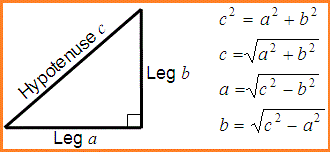Pythagorean Theorem Calculator Definition & Formula
Pythagorean Theorem Calculator – what is the Pythagorean theorem – Pythagorean Theorem (also know as- Pythagoras theorem) states that– In a right-angled triangle, square of the hypotenuse side is equal to the sum of squares of other two sides. If you knows any two sides of a right-angled triangle, you may finds the length of the third side with the help of Pythagorean Theorem. The above calculator provides accurate results, if you enter any two sides, it automatically calculates the third one. Pythagorean Theorem Calculator also calculates- Area of triangle, perimeter and value of h.
Pythagorean Theorem Formula/ Equation–
c2 = a2 + b2
where c = hypotenuse, a = Perpendicular and b = Base.
Moving further-
c= √(a² + b²)
a= √(c² – b²); and
b= √(c² – a²);On the basis of above Pythagorean Theorem formula- we can calculate the missing side; if we know the value of other two sides. We can find hypotenuse, if values of side a and b are known. We can also solve for values of a or b, if hypotenuse and side b or a is known. With the help of our Pythagorean Theorem Calculator, we can find any missing side of a right triangle.
Calculation of hypotenuse (C), Leg a and Leg b

To calculate hypotenuse (c), you need to have values of other two sides (value of a and value of b).
c= √(a² + b²)
Example– Find hypotenuse where a = 3 and b=4.
c= √(3² + 4²) = √(9 + 16)
c= √(25) = 5 Answer.
To calculate Leg (a) value, you need to have values of Leg (b) and hypotenuse;
a= √(c² – b²);
Example– Find Leg (a) value where Leg (b) = 5 and hypotenuse=7.
a= √(7² – 5²) = √(49 – 25)
a = √(24) = 4.898979 Answer.
To calculate Leg (b) value, you need to have values of Leg (a) and hypotenuse;
b= √(c² – a²);
Example– Find Leg (b) value where Leg (a) = 7 and hypotenuse=10.
b = √(10² – 7²) = √(100 – 49)
b = √(51) = 7.141428 Answer.
You don’t need to do calculations every-time; just put values in Pythagorean Theorem Calculator above, and it automatically calculates for you.
Calculation of Area, Perimeter and h
Formula for area of triangle (A) = (a × b)/2 and
Perimeter = sum of three sides = a + b + c
h = (a × b)/c
Example– Calculate Area, Perimeter and h of triangle where; a=2, b=3 and C=5.
Area of triangle (A) = (2 × 3)/2 = 6/2 = 3 and
Perimeter = 2 + 3 + 5 = 10 Answer.
h = (2 × 3)/5 = 1.6641 Answer.
References– we have taken references from various popular websites like- Google, Wikipedia etc. to write this article and Pythagorean Theorem Calculator. And if you finds this Pythagorean Theorem Calculator useful and accurate, please share with your friends.
Pythagorean Theorem FAQ’s (People Also Ask)
How do you calculate Pythagorean Theorem?
- Formula is = c2 = a2 + b2 [where ‘c’ is hypotenuse of a right triangle and ‘a’ and ‘b’ are other two sides].
How do you use the Pythagorean Theorem to find missing sides?
- If leg a is missing; a = √(c² – b²)
- If leg b is missing; b = √(c² – a²) and
- For hypotenuse; c = √(a² + b²)
How do you find C and Pythagorean Theorem?
- c = √(a² + b²)
What are the 3 Pythagorean triples?
- Pythagorean triples is a set of 3 positive integers for sides a and b and hypotenuse c, satisfying the Pythagorean Theorem formula;- c2 = a2 + b2
Example of Pythagorean triples – If a=3, b=4 and c=5.
c2 = a2 + b2
52 = 32 + 42
25 = 9 + 16
25 = 25
Hence 3, 4, 5 is a Pythagorean triples and three more Pythagorean triples are – (3, 4, 5), (6, 8,10), (5, 12, 13), (9, 12, 15) and many more.
